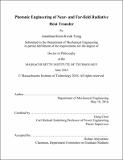Photonic engineering of near- and far-field radiative heat transfer
Author(s)
Tong, Jonathan Kien-Kwok
DownloadFull printable version (10.03Mb)
Other Contributors
Massachusetts Institute of Technology. Department of Mechanical Engineering.
Advisor
Gang Chen.
Terms of use
Metadata
Show full item recordAbstract
Radiative heat transfer is the process by which two objects exchange thermal energy through the emission and absorption of electromagnetic waves. It is one of nature's key fundamental processes and is ubiquitous in all facets of daily life from the light we receive from the Sun to the heat we feel when we place our hands near a fire. Fundamentally, radiative heat transfer is governed by the photonic dispersion, which describes all the electromagnetic states that can exist within a system. It can be modified by the material, the shape, and the environment. In this thesis, morphological effects are used to modify the photonic dispersion in order to explore alternative methods to spectrally shape, tune, and enhance radiative heat transfer from the near-field to the far-field regimes. We start by investigating the application of thin-film morphologies to different types of materials in the near-field regime using a rigorous fluctuational electrodynamics formalism. For thin-film semiconductors, trapped waveguide modes are formed, which simultaneously enhance radiative transfer at high frequencies where these modes are resonant and suppress radiative transfer at low frequencies where no modes are supported. This spectrally selective behavior is applied to a theoretical thermophotovoltaics (TPV) system where it is predicted the energy conversion efficiency can be improved. In contrast, thin-films of metals supporting surface plasmon polariton (SPP) modes will exhibit the opposite effect where the hybridization of SPP modes on both sides of the film will lead to a spectrally broadened resonant mode that can enhance near-field radiative transfer by over an order of magnitude across the infrared wavelength range. In order to observe these morphological spectral effects, suitable experimental techniques are needed that are capable of characterizing the spectral properties of near-field radiative heat transfer. To this end, we developed an experimental technique that consists of using a high index prism in an inverse Otto configuration to bridge the momentum mismatch between evanescent near-field radiative modes and propagation in free space in conjunction with a Fourier transform infrared (FTIR) spectrometer. Preliminary experimental results indicate that this method can be used to measure quantitative, gap-dependent near-field radiative heat transfer spectrally. While utilizing near-field radiative transfer remains a technologically challenging regime for practical application, morphological effects can still be used to modify the optical properties of materials in the far-field regime. As an example, we use polyethylene fibers to design an infrared transparent, visibly opaque fabric (ITVOF), which can provide personal cooling by allowing thermal radiation emitted by the human body to directly transmit to the surrounding environments while remaining visible opaque to the human eye.
Description
Thesis: Ph. D., Massachusetts Institute of Technology, Department of Mechanical Engineering, 2016. This electronic version was submitted by the student author. The certified thesis is available in the Institute Archives and Special Collections. Cataloged from student-submitted PDF version of thesis. Includes bibliographical references (pages 181-195).
Date issued
2016Department
Massachusetts Institute of Technology. Department of Mechanical EngineeringPublisher
Massachusetts Institute of Technology
Keywords
Mechanical Engineering.